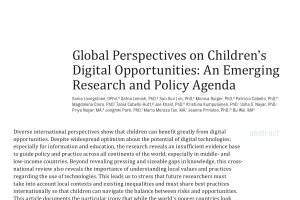Abstract
Diverse international perspectives show that children can benefit greatly from digital opportunities. Despite widespread optimism about the potential of digital technologies, especially for information and education, the research reveals an insufficient evidence base to guide policy and practice across all continents of the world, especially in middle- and low-income countries. Beyond revealing pressing and sizeable gaps in knowledge, this crossnational review also reveals the importance of understanding local values and practices regarding the use of technologies. This leads us to stress that future researchers must take into account local contexts and existing inequalities and must share best practices internationally so that children can navigate the balance between risks and opportunities. This article documents the particular irony that while the world’s poorer countries look to research to find ways to increase access and accelerate the fair distribution of digital educational resources, the world’s wealthier countries look to research for guidance in managing excessive screen time, heavily commercial content, and technologies that intrude on autonomy and privacy. We conclude by recommending that digital divides should be carefully bridged with contextual sensitivity to avoid exacerbating existing disparities; that the provision of technological resources is complemented by a focus on skills enhancement, for teachers as well as students; that a keen eye is needed to ensure the balance of children’s protection and participation rights, with protection now including data abuses as well as safety considerations; and that we forge collaborations among all stakeholders in seeking to enhance children’s digital opportunities worldwide.
Children around the world are increasingly benefitting from opportunities afforded by digital media, but the meanings children make and the consequences of this engagement depend on their different contexts. Optimistic promises regarding opportunities to communicate, learn, and participate are made to justify the provision of digital resources and Internet access to children globally. Yet these promises are countered by prominent public and policy concerns over the harms to children associated with society’s growing reliance on digitally networked technologies.
This article was published in a special 2017 supplement of Pediatrics, a journal of the American Academy of Pediatrics. The supplement, “Children, Adolescents and Screens: What We Know and What We Need To Learn,” was produced by Children and Screens and includes the contributions of more than 130 interdisciplinary authors across 22 papers. See a complete list of articles included in the supplement.
